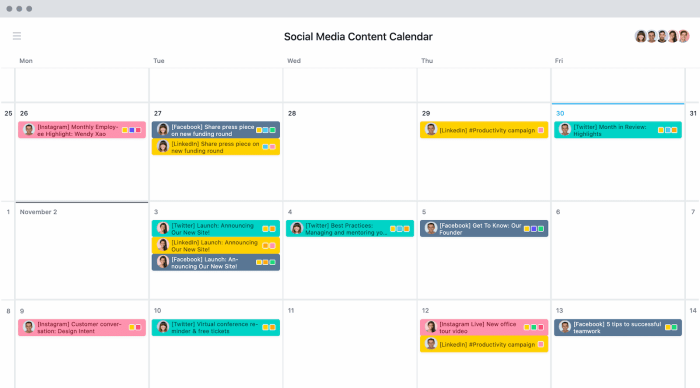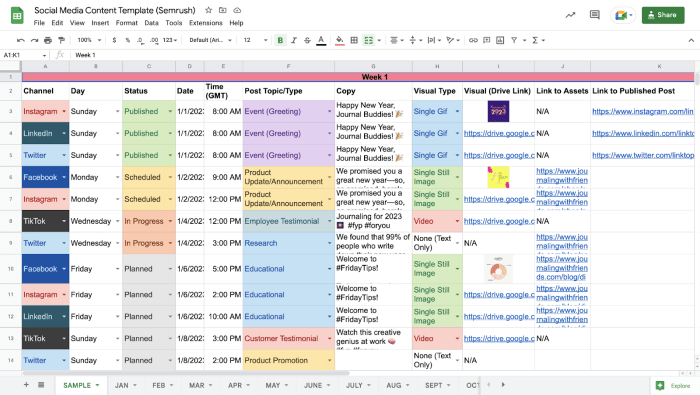Building a Content Calendar sets the stage for this enthralling narrative, offering readers a glimpse into a story that is rich in detail with american high school hip style and brimming with originality from the outset.
Get ready to dive into the world of content planning, organization, and creativity as we explore the ins and outs of crafting a killer content calendar.
Benefits of Building a Content Calendar

Creating a content calendar can bring a whole lot of goodness to your content game. From keeping you on track to boosting your creativity, let’s dive into why having a structured content calendar is a must-have.
Improved Organization and Planning
Having a content calendar is like having a roadmap for your content journey. It helps you stay organized, plan ahead, and avoid that last-minute content scramble. With a clear plan in place, you can ensure that your content aligns with your goals and targets the right audience at the right time.
Enhanced Content Consistency and Quality
Consistency is key when it comes to building a strong brand presence. A content calendar allows you to maintain a consistent posting schedule, tone, and messaging across all your platforms. This not only helps in building brand recognition but also ensures that your content is of high quality and resonates with your audience. Plus, by planning your content in advance, you can dedicate more time to creating engaging and impactful content that drives results.
Creating a Content Calendar Template
Creating a content calendar template is essential for organizing your content strategy and ensuring consistency in your posting schedule. By having a structured template, you can plan ahead, stay on track with your content goals, and effectively manage your publishing platforms.
Designing a Simple Content Calendar Template
To design a simple content calendar template for weekly content planning, start with a basic spreadsheet or calendar format. Include columns for the following key elements:
- Content Types: Specify whether your content will be a blog post, video, infographic, social media post, etc.
- Topics: Artikel the specific topics or themes you plan to cover each week.
- Deadlines: Set clear deadlines for when each piece of content needs to be completed.
- Publishing Platforms: Indicate where you will be posting or sharing your content, such as your website, social media channels, or email newsletters.
Customizing Your Content Calendar Template
Customize your content calendar template based on your specific needs and goals by adjusting the format, adding additional columns, or color-coding different types of content. You can also include sections for s, target audience, and performance metrics to track the success of your content strategy. Tailor the template to fit your workflow and make it easy to use for everyone involved in the content creation process.
Content Ideas and Brainstorming

Generating fresh content ideas is crucial to maintaining an engaging content calendar that resonates with your target audience. Brainstorming sessions can help spark creativity and lead to unique content concepts that set your brand apart. Here are some methods for generating content ideas:
Utilize Research
- Research popular s related to your industry or niche
- Identify trending topics and incorporate them into your content calendar
- Use tools like Google Planner or SEMrush to discover new content opportunities
Tap into Social Media Trends
- Monitor social media platforms for trending topics, hashtags, and conversations
- Engage with your followers to understand their interests and preferences
- Create content that aligns with current social media trends to stay relevant
Diversify Content Types and Formats
- Experiment with different content formats such as videos, infographics, blog posts, and podcasts
- Cater to different learning styles and preferences of your audience
- Keep your content calendar dynamic and engaging by mixing up the types of content you produce
Collaborating and Communicating with Team Members
When it comes to populating and managing a content calendar, collaboration and communication with team members are key. Here are some strategies to ensure seamless coordination:
Utilizing Communication Tools and Platforms, Building a Content Calendar
Effective use of communication tools and platforms can greatly enhance collaboration within a team working on a content calendar. Here are some tips:
- Utilize project management tools like Trello or Asana to assign tasks and track progress.
- Set up regular meetings or check-ins to discuss upcoming content and address any challenges.
- Establish clear channels of communication, whether it’s through email, Slack, or other messaging platforms.
Delegating Tasks and Responsibilities
Delegating tasks and responsibilities within a content calendar framework is crucial for efficiency. Here are some tips to ensure effective delegation:
- Clearly define roles and responsibilities for each team member to avoid confusion.
- Assign tasks based on team members’ strengths and expertise to maximize efficiency.
- Set deadlines and milestones to keep everyone on track and accountable.





